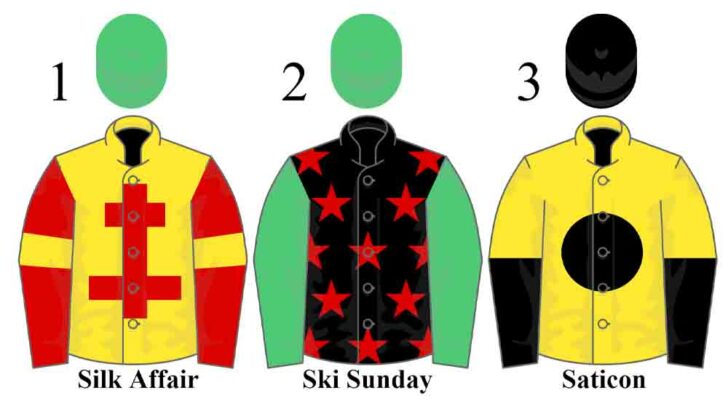Jockey Silk Colors

Image source: JockeyColours / CC BY-SA via Wikimedia Commons
Introduction: Jockey Silk Colors
Back in the days of ancient Rome, the chariot drivers were wearing colored tunics. This was to distinguish one driver from another during the rapid and hectic races. Today, the tradition continues in Italy, with the jockeys in the famous Palio Race wearing the colors of their villages.
Jockey Silk Colors: The Jockey Club
Their modern usage goes back to the early days of the Jockey Club in England. In 1762, 19 members of the club got together at the Newmarket racetrack. They said that they would officially register their colors. Some of these same colors still remain in the hands of generations of owners. For example, Lord Derby still uses the colors of a black and white button and a white cap. Back in those days, the idea was to be able to distinguish one rider from another during the general melee of racing. As they put it, “for the greater convenience of distinguishing the horses in running”. And also for the practical consideration that the prize money should go to the correct owner post-race.
Can’t See The Horse Numbers
Today all horses bear numbers on them, called “saddle clothes”, for identification purposes. But modern track announcers still stick with the old system of jockey silks to place the horses during a race, as well as identify them in the paddock both before and after a race. But in truth, with horse racing being as competitive and closely run as it is, there are many times when the horse number is obscured and so the jockey silk colors are the only means by which to know who is who. Now you can’t just have any colors you might fancy. Your racehorse cannot go racing dressed like Prince.
Jockey Silk Colors: Choose Your Colors
There are rules governing all aspects of jockey silk colors. These are laid down by the International Federation of Horseracing. When you are planning, designing and manufacturing your silks, then you must limit your choices to just 18 colors, with 25 body designs and 12 sleeve designs. Most owners want the colors to reflect some aspect of the business that’s financing the horse. For example, owner Eugene Melnyk designed his racing colors around the flag of Barbados, as that’s where he lives. Joint owners, Bob and Beverly Lewis chose green and yellow horizontal stripes, as that’s the colors of their alma mater the University of Oregon. The rules are strict, you can use initial letters as part of your design. The owner Allen Poulson uses a large “AP” monogram and Charles Howard, the owner of Seabiscuit, uses an “H” inside an inverted triangle.

Changing Colors
Over time the color of an owners’ silks can change. Stronach Stables used to use a light blue with a black diamond in the center for their jockey silk colors. They now sport red, black and gold “A” design after changing in 1990. During its heyday, Calumet farms were using the devil’s red with blue stripes and a blue cap. But the current owner, Brad Kelly, decided that he preferred black with golden chevrons. If we go back to the 1700s, then one of those initial 19 members was Lord Derby. He started with green and white stripes. Today his jockey silk colors are black and white. The white buttons seen on his jockey’s silks were added in 1924. This was a matter of superstition after his horse won his namesake’s race at Epson Downs.
Jockey Silk Colors: Only For Horse Racing
One point of interest is that jockey’s silk colors only apply to Thoroughbred and Quarter bred horse racing. It does not extend to harness racing. In this latter sport, the drivers make their own designs for both shirts and caps.
If you would like to learn more about horse race betting check out our collection of online jackpot sites.
Click here to visit the Unibet Sportsbook to discover the world of horse racing














